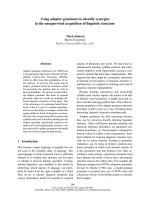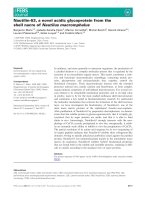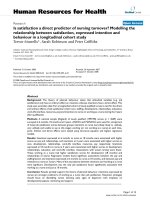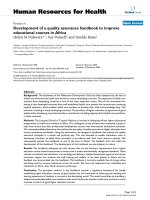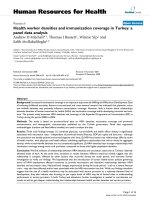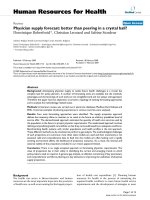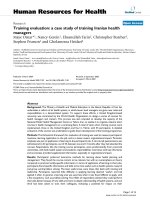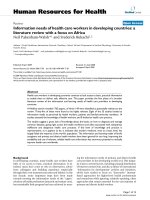Báo cáo sinh học: " Seewis virus, a genetically distinct hantavirus in the Eurasian common shrew (Sorex araneus)" doc
Bạn đang xem bản rút gọn của tài liệu. Xem và tải ngay bản đầy đủ của tài liệu tại đây (257.77 KB, 5 trang )
BioMed Central
Page 1 of 5
(page number not for citation purposes)
Virology Journal
Open Access
Short report
Seewis virus, a genetically distinct hantavirus in the Eurasian
common shrew (Sorex araneus)
Jin-Won Song*
1
, Se Hun Gu
1
, Shannon N Bennett
2
, Satoru Arai
2
,
Maria Puorger
3
, Monika Hilbe
3
and Richard Yanagihara
2
Address:
1
Department of Microbiology, College of Medicine, and Institute for Viral Diseases, Korea University, 5-ga, Anam-dong, Sungbuk-gu,
Seoul 136-705, Korea,
2
Departments of Tropical Medicine and Medical Microbiology and of Pediatrics, John A. Burns School of Medicine,
University of Hawai'i at Manoa, 651 Ilalo Street, Honolulu, HI 96813, USA and
3
Institute of Veterinary Pathology, University of Zurich,
Winterthurerstr. 268, 8057 Zürich, Switzerland
Email: Jin-Won Song* - ; Se Hun Gu - ; Shannon N Bennett - ;
Satoru Arai - ; Maria Puorger - ; Monika Hilbe - ;
Richard Yanagihara -
* Corresponding author
Abstract
More than 20 years ago, hantaviral antigens were reported in tissues of the Eurasian common
shrew (Sorex araneus), Eurasian water shrew (Neomys fodiens) and common mole (Talpa europea),
suggesting that insectivores, or soricomorphs, might serve as reservoirs of unique hantaviruses.
Using RT-PCR, sequences of a genetically distinct hantavirus, designated Seewis virus (SWSV), were
amplified from lung tissue of a Eurasian common shrew, captured in October 2006 in Graubünden,
Switzerland. Pair-wise analysis of the full-length S and partial M and L segments of SWSV indicated
approximately 55%–72% similarity with hantaviruses harbored by Murinae, Arvicolinae,
Neotominae and Sigmodontinae rodents. Phylogenetically, SWSV grouped with other recently
identified shrew-borne hantaviruses. Intensified efforts are underway to clarify the genetic diversity
of SWSV throughout the geographic range of the Eurasian common shrew, as well as to determine
its relevance to human health.
Findings
Viruses antigenically related to Hantaan virus (HTNV),
the prototype virus of hemorrhagic fever with renal syn-
drome, have been isolated from the Asian house shrew
(Suncus murinus), greater white-toothed shrew (Crocidura
russula) and Chinese mole shrew (Anourosorex squamipes)
[1-4], indicating that shrews are capable of serving as inci-
dental hosts of hantaviruses typically harbored by
rodents. Insectivores, or soricomorphs, also appear to har-
bor genetically distinct hantaviruses, as evidenced by the
recent demonstration of Camp Ripley virus (RPLV) in the
northern short-tailed shrew (Blarina brevicauda) [5], Cao
Bang virus (CBNV) in the Chinese mole shrew [6], Tan-
ganya virus (TGNV) in the Therese shrew (Crocidura there-
sae) [7], and Ash River virus and Jemez Springs virus in the
masked shrew (Sorex cinereus) and the dusky shrew (Sorex
monticolus), respectively [8]. Moreover, Thottapalayam
virus (TPMV), a previously unclassified virus isolated
from the Asian house shrew [9,10], is now known to be a
bona fide shrew-borne hantavirus [11-14].
Earlier reports of hantaviral antigens in tissues of the Eur-
asian common shrew (Sorex araneus), alpine shrew (Sorex
alpinus), Eurasian water shrew (Neomys fodiens) and com-
Published: 30 October 2007
Virology Journal 2007, 4:114 doi:10.1186/1743-422X-4-114
Received: 16 September 2007
Accepted: 30 October 2007
This article is available from: />© 2007 Song et al; licensee BioMed Central Ltd.
This is an Open Access article distributed under the terms of the Creative Commons Attribution License ( />),
which permits unrestricted use, distribution, and reproduction in any medium, provided the original work is properly cited.
Virology Journal 2007, 4:114 />Page 2 of 5
(page number not for citation purposes)
mon mole (Talpa europea), captured in European Russia
and the former Yugoslavia [15-17], have largely gone
unnoticed. In this short report, we present the genetic and
phylogenetic analyses of a new hantavirus, designated
Seewis virus (SWSV), detected in the Eurasian common
shrew. These findings add to the expanding database on
soricid-associated hantaviruses and forecast that many
more hantaviruses will be found in diverse shrew species
throughout Eurasia.
Liver tissue from three Crocidura leucodon and lung tissue
from one Neomys anomalus and five Sorex araneus, cap-
tured during August and October 2006, in the village of
Seewis (46°59'N, 9°38'E), located in the Swiss canton of
Graubünden, a region endemic for Borna disease located
approximately 130 kilometers east of Zurich [18], were
studied. Total RNA, extracted from 20–50 mg of each tis-
sue, using the RNA-Bee™ isolation kit (TEL-TEST, Inc.,
Friendswood, TX), was reverse transcribed, using M-MLV
reverse transcriptase (Promega, Madison, WI) and a con-
served primer (OSM55: 5'-TAGTAGTAGACTCC-3' and
SWS S1093F: 5'-TACAGCTGAGGAGAAGC-3' for the S
segments; OSM55 and SWS L1351F: 5'-CAAGGCCCAG-
CAAAACATAC-3' for the L segment; and OSV697: 5'-
GGACCAGGTGCADCTTGTGAAGC-3' for the M seg-
ment).
Gene-amplification reactions were performed in 50-μL
mixtures, containing 200 μM dNTP, 0.5 U of super-therm
polymerase (PureTech Co., Ltd. Seoul, Korea), 1 μg of
cDNA and 10 pM of each primer. Oligonucleotide primer
sequences for nested PCR, designed from TPMV and other
hantaviruses, were OSM55 and OSV845: 5'-CTTAGCTCG-
GGATCCATRTC-3', then OSM55 and OSV847: 5'-TAT-
CATCACCMAGRTGGAA-3', SWS S1130F: 5'-
TACCAATCTTATCTGCGTC-3' and CBS-3'endR: 5'-TAG-
TAGTAKRCTCCYTRAA-3' for the S segment; OSV697 and
T-M1485R: 5'-CCAGCCAAARCARAATGT-3', then T-
M1199F: 5'-TAAVTTCAMCAAC ATGTCT-3' and T-
M1485R for the M segment; and OSM55 and T-L1454R:
5'-ATGCCC WATATGCCATGC-3', then OSM55 and T-
L390R: 5'-GTCACWGTRACCTC-3', MJN L181F: 5'-ATGA-
GATGATAAARCATGA-3' and T-L1454R, SWS L1351F and
PHL 3445R: 5'-GRTTAAACATACTCTTCCTCCACATCTC-
3', then SWS L1351F and SWS L2180R: 5'-GTA ACCTCA-
GATATCAAGC-3' for the L segment. Initial denaturation
was at 94°C for 5 min, followed by touchdown cycling
with denaturation at 94°C for 40 sec, annealing from
50°C to 37°C for 40 sec, elongation at 68°C for 1 min 20
sec, then 25 cycles of denaturation at 94°C for 40 sec,
annealing at 40°C for 40 sec and elongation at 68°C for
1 min 20 sec in a Mastercycler ep gradient S (Eppendorf
AG, Hamburg, Germany). PCR products were purified by
the Wizard PCR Preps DNA Purification System
(Promega), and DNA sequences of at least three clones of
each amplicon were determined in both directions, using
the dye primer cycle sequencing ready reaction kit
(Applied Biosystems, Foster City, CA) on an automated
sequencer (Model 377, Perkin Elmer Co.) [19]. DNA
sequences were then aligned using Clustal W [20] and
transAlign [21] with publicly available hantavirus
sequences and analyzed phylogenetically by PAUP ver-
sion 4.0 [22] and RAxML [23]. The maximum likelihood
(ML) method under the GTR+I+G model of evolution, as
selected by Modeltest v.3.7 [24], was used, and ML boot-
strap support was generated using the RAxML web-server
prototype that implements a novel rapid bootstrapping
algorithm [25].
Host identification was confirmed by mitochondrial DNA
(mtDNA) sequencing. Briefly, the cytochrome b region of
mtDNA was amplified by PCR, using previously described
universal primers, which permit amplification of a 482-bp
product (L14115: 5'-CGAAGCTTGATATGA AAAAC-
CATCGTTG-3'; L14532: 5'-GCAGCCCCTCAGAATGA-
TATTTGTCCAC-3') [26].
Unique hantavirus sequences of the S, M and L segments
were amplified from lung tissue of a single S. araneus. The
full-length S-genomic segment of SWSV strain mp70 was
1,641 nucleotides, with a predicted nucleocapsid protein
of 429 amino acids, starting at nucleotide position 40,
and a 314-nucleotide 3'-noncoding region. Pair-wise
alignment and comparison of the coding region of the S
segment indicated genetic similarities of 55.3–58.1% and
55.8–61.0% at the nucleotide and amino acid levels,
respectively, from representative Murinae, Arvicolinae,
Neotominae and Sigmodontinae rodent-borne hantavi-
ruses. Unexpectedly, SWSV was even less similar to TPMV
VRC-66412 (49.3% at the nucleotide and 44.2% at the
amino acid level). As in other soricid-borne hantaviruses
discovered to date, the hypothetical NSs opening reading
frame, typically found in Arvicolinae and Neotominae
rodent-borne hantaviruses, was not found in SWSV.
Analysis of a 250-nucleotide region of the Gn glycopro-
tein-encoding M segment also exhibited low nucleotide
sequence similarity to rodent-associated hantaviruses,
including HTNV 76–118 (68.8%), Dobrava virus (DOBV)
AP99 (69.9%), Soochong virus (SOOV) SC-1 (72.4%),
Seoul virus (SEOV) HR80-39 (72.0%), Puumala virus
(PUUV) Sotkamo (65.0%), Tula virus (TULV) M5302v
(66.4%) and Sin Nombre virus (SNV) NMH10 (68.8%).
And comparison of a 3,327-nucleotide region of the L seg-
ment showed similar degrees of sequence identity of
approximately 65% between SWSV and rodent-borne
hantaviruses.
Phylogenetic analyses, based on the full-length S and par-
tial M and L segments, generated by the ML method, indi-
Virology Journal 2007, 4:114 />Page 3 of 5
(page number not for citation purposes)
cated that SWSV was distinct from rodent-borne
hantaviruses (Figure 1). In the representative ML trees,
based on M- and L-segment sequences, SWSV clustered
with CBNV and RPLV, two recently identified hantavi-
ruses harbored by soricine shrews. S-segment analysis fur-
ther supported the close relationship between SWS and
CBNV. While TPMV was consistently more divergent phy-
logenetically from SWSV than even the rodent-borne
hantaviruses, TGNV was not (Figure 1). In such trees,
SWSV, although distinct, shared a more recent common
ancestor with Murinae rodent-borne hantaviruses than
with TPMV, suggesting a possible host-switching event in
the distant past.
RT-PCR amplification of SWSV presented unanticipated
challenges. While still cool on arrival, the small amount of
tissue from the single infected shrew had thawed in tran-
sit, resulting in a low RNA yield, which limited the
options in cDNA synthesis. Also, the divergent genome of
SWSV made difficult the designing of suitable primers.
Although these difficulties were partly overcome, they
contributed to our inability to obtain the full genome of
SWSV. Future work will be necessary to complete this task
and to isolate SWSV in cell culture.
Although several viruses have been isolated from sorico-
morphs, including Erve virus from Crocidura russula [27],
tick-borne encephalitis virus from Talpa europea [28] and
S. araneus [29], and a canine distemper-like paramyxovi-
rus from Erinaceus europeus [30], their detection has been
largely incidental or accidental. By contrast, our study spe-
cifically targeted the identification of new hantaviruses in
shrews, as a means of better understanding their evolu-
tionary origins. In some ways, however, the demonstra-
tion of a phylogenetically distinct hantavirus in the
Eurasian common shrew was not surprising and was thor-
oughly consistent with decades-old reports of hantavirus
antigens in S. araneus in the former Yugoslavia and Russia
[15-17]. The important distinction is that we now have
sequence data to substantiate the existence of a hantavirus
in the Eurasian common shrew. Further support for this
long co-evolutionary relationship is provided by the
recent detection of SWSV sequences in S. araneus captured
Phylogenetic relationships between Seewis virus (SWSV) and representative rodent- and soricid-borne hantaviruses, using the GTR+I+G model of evolutionFigure 1
Phylogenetic relationships between Seewis virus (SWSV) and representative rodent- and soricid-borne hanta-
viruses, using the GTR+I+G model of evolution. Maximum likelihood phylogenies, based on full-length coding alignments
of S, M and L segments, incorporating 1,290, 250 and 3,300 nucleotides, respectively, of SWSV strain mp70, shown in relation-
ship to representative Murinae rodent-borne hantaviruses, including Hantaan virus (HTNV 76–118, NC_005218, NC_005219,
NC_005222), Dobrava virus (DOBV Greece, NC_005233, NC_005234, NC_005235), and Seoul virus (SEOV 80–39,
NC_005236, NC_005237, NC_005238); Arvicolinae rodent-borne hantaviruses, including Tula virus (TULV M5302v,
NC_005227, NC_005228, NC_005226), Prospect Hill virus (PHV PH-1, Z49098, X55128, EF646763) and Puumala virus
(PUUV Sotkamo, NC_005224, NC_005223, NC_005225); and Sigmodontinae and Neotominae rodent-borne hantaviruses,
including Andes virus (ANDV Chile 9717869, NC_003466, NC_003467, NC_003468) and Sin Nombre virus (SNV NMH10,
NC_00521, NC_005215, NC_005217). Also included are Camp Ripley (RPLV MSB89863, EF540771, EF540774) from the
northern short-tailed shrew (Blarina brevicauda), Cao Bang virus (CBNV TC-3, EF543524, EF543525, EF543526) from the Chi-
nese mole shrew (Anourosorex squamipes), Tanganya virus (TGNV Tan826, EF050454, EF050455) from the Therese shrew (Cro-
cidura theresae), and Thottapalayam virus (TPMV VRC-66412, AY526097, EU001329, EU001330) from the Asian house shrew
(Suncus murinus). The numbers at each node are bootstrap support values (expressed as the percentage of replicates in which
the node was recovered), as determined for 100 ML replicates using RAxML [25]. The scale bar indicates 0.1 nucleotide substi-
tutions per site. GenBank accession numbers for SWSV: S (EF636024
); M (EF636025) and L (EF636026).
Virology Journal 2007, 4:114 />Page 4 of 5
(page number not for citation purposes)
in Hungary and Finland (S. Arai and R. Yanagihara,
unpublished observations).
Found in woodlands, grasslands and hedgelands through-
out Northern Europe, including Scandinavia and Great
Britain (but excluding Ireland), and extending throughout
Russia, S. araneus (family Soricidae, subfamily Soricinae)
is among the most widely dispersed small mammal spe-
cies in Eurasia. Although their nests are generally made
underground or under dense vegetation, they occasionally
occupy burrows of mice, voles and moles. While solitary,
their extremely aggressive territorial behavior and carniv-
orous eating habits make plausible the acquisition and
transmission of hantavirus infection through wounding.
However, to what extent such host-switching events might
have occurred in the distant past is unknown. Neverthe-
less, as judged by the nucleotide sequence analyses of the
S-, M- and L-genomic segments, the polyphylogenetic
relationships of SWSV and other soricid- and rodent-asso-
ciated hantaviruses are suggestive. The discovery and
genetic characterization of other soricid-borne hantavi-
ruses will clarify whether the reservoir host of the primor-
dial hantavirus was harbored by a soricid or rodent
ancestor.
As recently estimated from sequence analysis of cyto-
chrome b mtDNA and nuclear genes BRCA1 and ApoB,
the Palearctic and Nearctic Soricinae (i.e., Sorex in Eurasia
and Otisorex in North America) diverged approximately
14 million years before present [31]. In this regard, the
identification of genetically distinct hantaviruses in North
American soricines, such as S. cinereus and S. monticolus in
the United States [8], will aid in the elucidation of the
phylogeography and parallel co-evolution of Sorex-borne
hantaviruses in the Old and New Worlds. Also, intensified
efforts to isolate SWSV and other hantaviruses harbored
by shrews will clarify their importance to human health.
Competing interests
The author(s) declare that they have no competing inter-
ests.
Authors' contributions
JWS coordinated the implementation of the project,
including the design of oligonucleotide primers and opti-
mization of gene-amplification reactions. SHG performed
the RNA extraction, RT-PCR and DNA sequencing. SNB
performed the sequence and phylogenetic analyses. SA
participated in the design of RT-PCR primers. MP and MH
provided tissues and background data of wild-caught
shrews. RY conceived the study design, arranged the col-
laboration and provided oversight. All authors contrib-
uted to the preparation of the manuscript.
Acknowledgements
This work was supported in part by grants from MOST (KOSEF), Korea
(R21-2005-000-10017-0) and the U.S. Department of Defense, Global
Emerging Infections Surveillance and Response System (GEIS), Silver Spring,
MD, and the Armed Forces Medical Intelligence Center (AFMIC), Ft. Det-
rick, MD, as well as by grants P20RR018727 (Centers of Biomedical
Research Excellence) and G12RR003061 (Research Centers in Minority
Institutions) from the National Center for Research Resources, National
Institutes of Health. The research on wild-caught shrew tissues was exempt
from review by the University of Hawaii Animal Care and Use Committee.
References
1. Tang YW, Xu ZY, Zhu ZY, Tsai TF: Isolation of HFRS virus from
Suncus murinus, an insectivore. Lancet 1985, i:513.
2. Chen SZ, Chen LL, Tao GF, Fu JL, Zhang CA, Wu YT, Luo LJ, Wang
YZ: [Strains of epidemic hemorrhagic fever virus isolated
from the lungs of C. russula and A. squamipes]. Chin J Prev Med
1986, 20:261-263.
3. Yan DY, Xie YJ, Zhang CA, McCormick JB, Sanchez A, Engelman HM,
Chen SZ, Gu XS, Tang WT, Zhang J: New isolates of HFRS virus
in Sichuan, China, and characterization of antigenic differ-
ences by monoclonal antibodies. Lancet 1986, i:1328.
4. Tang YW, Ruo SL, Sanchez A, Fisher-Hoch SP, McCormick JB, Xu ZY:
Hantavirus strains isolated from rodentia and insectivora in
rural China differentiated by polymerase chain reaction. Arch
Virol 1990, 115:37-46.
5. Arai S, Song J-W, Sumibcay L, Bennett SN, Nerurkar VR, Parmenter
C, Cook JA, Yates TL, Yanagihara R: Hantavirus in northern
short-tailed shrew, United States. Emerg Infect Dis 2007,
13:1420-1423.
6. Song J-W, Kang HJ, Song KJ, Truong TT, Bennett SN, Arai S, Truong
NU, Yanagihara R: Newfound hantavirus in Chinese mole
shrew, Vietnam. Emerg Infect Dis 2007, 13:1784-1787.
7. Klempa B, Fichet-Calvet E, Lecompte E, Auste B, Aniskin V, Meisel H,
Barrier P, Koivogui L, ter Meulen J, Kruger DH: Novel hantavirus
sequences in shrew, Guinea. Emerg Infect Dis 2007, 13:520-522.
8. Arai S, Bennett SN, Sumibcay L, Cook JA, Song J-W, Hope A, Par-
menter C, Nerurkar VR, Yates TL, Yanagihara R: Phylogenetically
distinct hantaviruses in the masked shrew (Sorex cinereus)
and dusky shrew (Sorex monticolus) in the United States. Am
J Trop Med Hyg in press.
9. Carey DE, Reuben R, Panicker KN, Shope RE, Myers RM: Thotta-
palayam virus: a presumptive arbovirus isolated from a
shrew in India. Indian J Med Res 1971, 59:1758-1760.
10. Zeller HG, Karabatsos N, Calisher CH, Digoutte J-P, Cropp CB, Mur-
phy FA, Shope RE: Electron microscopic and antigenic studies
of uncharacterized viruses. II. Evidence suggesting the place-
ment of viruses in the family Bunyaviridae. Arch Virol 1989,
108:211-227.
11. Schmaljohn CS, Hasty SE, Dalrymple JM, LeDuc JW, Lee HW, von
Bonsdorff CH, Brummer-Korvenkontio M, Vaheri A, Tsai TF, Regn-
ery HL, Goldgaber D, Lee P-W: Antigenic and genetic properties
of viruses linked to hemorrhagic fever with renal syndrome.
Science 1985, 227:1041-1044.
12. Chu YK, Lee HW, LeDuc JW, Schmaljohn CS, Dalrymple JM: Sero-
logical relationships among viruses in the Hantavirus genus,
family Bunyaviridae. Virology 1994, 198:196-204.
13. Xiao S-Y, LeDuc JW, Chu YK, Schmaljohn CS: Phylogenetic analy-
ses of virus isolates in the genus Hantavirus, family Bunya-
viridae. Virology 1994, 198:205-217.
14. Song J-W, Baek LJ, Schmaljohn CS, Yanagihara R: Thottapalayam
virus: a prototype insectivore-borne hantavirus. Emerg Infect
Dis 2007, 13:980-985.
15. Gavrilovskaya IN, Apekina NS, Myasnikov YuA, Bernshtein AD, Rylt-
seva EV, Gorbachkova EA, Chumakov MP: Features of circulation
of hemorrhagic fever with renal syndrome (HFRS) virus
among small mammals in the European U.S.S.R. Arch Virol
1983, 75:313-316.
16. Tkachenko EA, Ivanov AP, Donets MA, Myasnikov YA, Ryltseva EV,
Gaponova LK, Bashkirtsev VN, Okulova NM, Drozdov SG, Slonova
RA, Somov GP: Potential reservoir and vectors of haemor-
rhagic fever with renal syndrome (HFRS) in the U.S.S.R. Ann
Soc Belg Med Trop 1983, 63:267-269.
Publish with Bio Med Central and every
scientist can read your work free of charge
"BioMed Central will be the most significant development for
disseminating the results of biomedical research in our lifetime."
Sir Paul Nurse, Cancer Research UK
Your research papers will be:
available free of charge to the entire biomedical community
peer reviewed and published immediately upon acceptance
cited in PubMed and archived on PubMed Central
yours — you keep the copyright
Submit your manuscript here:
/>BioMedcentral
Virology Journal 2007, 4:114 />Page 5 of 5
(page number not for citation purposes)
17. Gligic A, Stojanovic R, Obradovic M, Hlaca D, Dimkovic N, Diglisic G,
Lukac V, Ler Z, Bogdanovic R, Antonijevic B, Ropac D, Avsic T, LeDuc
JW, Ksiazek T, Yanagihara R, Gajdusek DC: Hemorrhagic fever
with renal syndrome in Yugoslavia: epidemiologic and epiz-
ootiologic features of a nationwide outbreak in 1989. Eur J Epi-
demiol 1992, 8:816-825.
18. Hilbe M, Herrsche R, Kolodziejek J, Nowotny N, Zlinszky K,
Ehrensperger F: Shrews as reservoir hosts of Borna disease
virus. Emerg Infect Dis 2006, 12:675-677.
19. Baek LJ, Kariwa H, Lokugamage K, Yoshimatsu K, Arikawa J,
Takashima I, Chung SY, Lee EJ, Moon SS, Song K-J, Klein TA, Yanagi-
hara R, Song J-W: Soochong virus: a genetically distinct hanta-
virus isolated from Apodemus peninsulae in Korea. J Med Virol
2006, 78:290-297.
20. Thompson JD, Higgins DG, Gibson TJ: CLUSTAL W: improving
the sensitivity of progressive multiple sequence alignment
through sequence weighting, position-specific gap penalties
and weight matrix choice. Nucleic Acids Res 1994, 22:4673-4680.
21. Bininda-Emonds ORP: transAlign: using amino acids to facili-
tate the multiple alignment of protein-coding DNA
sequences. BMC Bioinformatics 2005, 6:156.
22. Swofford DL: PAUP* Phylogenetic Analysis Using Parsimony
(*and Other Methods). Version 4. Sinauer Associates, Sunderland,
Massachusetts; 2003.
23. Stamatakis A: RAxML-VI-HPC: maximum likelihood-based
phylogenetic analyses with thousands of taxa and mixed
models. Bioinformatics 2006, 22:2688-2690.
24. Posada D, Crandall KA: MODELTEST: testing the model of
DNA substitution. Bioinformatics 1998, 14:817-818.
25. RAxML BlackBox. [ />]
26. Smith MF, Patton JL: Variation in mitochondrial cytochrome b
sequence in natural populations of South American Akodon-
tine rodents (Murinae: Sigmodontinae). Mol Biol Evol 1991,
8:85-103.
27. Chastel C, Main AJ, Richard P, Le Lay G, Legrand-Quillien MC, Beau-
cournu JC: Erve virus, a probable member of Bunyaviridae
family isolated from shrews (Crocidura russula) in France.
Acta Virol 1989, 33:270-280.
28. Kozuch O, Grulich I, Nosek J: Serological survey and isolation of
tick-borne encephalitis virus from the blood of the mole
(Talpa europaea) in a natural focus. Acta Virol 1966, 10:557-560.
29. Kozuch O, Lichard M, Nosek J, Chmela J: Isolation of tick-borne
encephalitis virus from the blood of Sorex araneus in a natu-
ral focus. Acta Virol 1967, 11:563.
30. Vizoso AD, Thomas WE: Paramyxoviruses of the morbilli
group in the wild hedgehog Erinaceus europeus. Br J Exp Pathol
1981, 62:79-86.
31. Dubey S, Salamin N, Ohdachi SD, Barriére P, Vogel P: Molecular
phylogenetics of shrews (Mammalia: Soricidae) reveals tim-
ing of transcontinental colonizations. Mol Phylogenet Evol 2007,
44:126-137.
